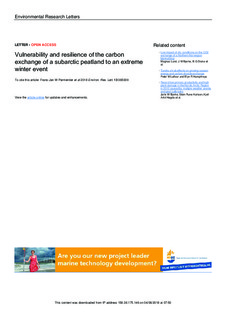Vulnerability and resilience of the carbon exchange of a subarctic peatland to an extreme winter event
Parmentier, Frans-Jan; Rasse, Daniel P.; Lund, Magnus; Bjerke, Jarle W.; Drake, Bert G.; Weldon, Simon Mark; Tømmervik, Hans; Hansen, Georg Heinrich
Journal article, Peer reviewed
Published version

Åpne
Permanent lenke
http://hdl.handle.net/11250/2502413Utgivelsesdato
2018Metadata
Vis full innførselSamlinger
- Publikasjoner fra CRIStin - NINA [2364]
- Scientific publications [1392]
Originalversjon
10.1088/1748-9326/aabff3Sammendrag
Extreme winter events that damage vegetation are considered an important climatic cause of arctic
browning—a reversal of the greening trend of the region—and possibly reduce the carbon uptake of
northern ecosystems. Confirmation of a reduction in CO2 uptake due to winter damage, however,
remains elusive due to a lack of flux measurements from affected ecosystems. In this study, we report
eddy covariance fluxes of CO2 from a peatland in northern Norway and show that vegetation CO2
uptake was delayed and reduced in the summer of 2014 following an extreme winter event earlier that
year. Strong frost in the absence of a protective snow cover—its combined intensity unprecedented in
the local climate record—caused severe dieback of the dwarf shrub species Calluna vulgaris and
Empetrum nigrum. Similar vegetation damage was reported at the time along ∼1000 km of coastal
Norway, showing the widespread impact of this event. Our results indicate that gross primary
production (GPP) exhibited a delayed response to temperature following snowmelt. From snowmelt
up to the peak of summer, this reduced carbon uptake by 14 (0–24) g Cm−2 (∼12% of GPP in that
period)—similar to the effect of interannual variations in summer weather. Concurrently,
remotely-sensed NDVI dropped to the lowest level in more than a decade. However, bulk
photosynthesis was eventually stimulated by the warm and sunny summer, raising total GPP. Species
other than the vulnerable shrubs were probably resilient to the extreme winter event. The warm
summer also increased ecosystem respiration, which limited net carbon uptake. This study shows that
damage from a single extreme winter event can have an ecosystem-wide impact on CO2 uptake, and
highlights the importance of including winter-induced shrub damage in terrestrial ecosystem models
to accurately predict trends in vegetation productivity and carbon sequestration in the Arctic and
sub-Arctic.
